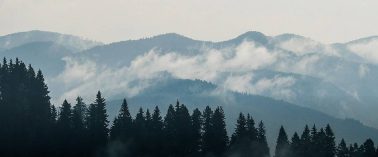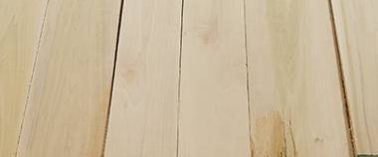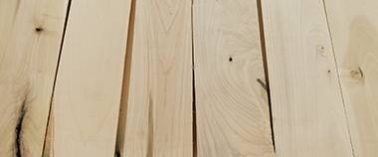Appalachian Species & Grades
Poplar
Other Common Names: Tulipwood, Tulip-Poplar, White-Poplar, Yellow Poplar, Whitewood
Poplar is one of the most common utility hardwoods in the United States. Its sapwood is white, sometimes with stripes; the heartwood is usually tan, but can range from greenish brown to dark green, purple, black, blue and yellow. The wood is straight-grained, uniform in texture and moderate to lightweight. It has a medium density, machines, and glues well. It takes a variety of finishes well. Yellow Poplar is used in furniture, doors, millwork, baskets and picture frames.
It is also used for pallets, crates, construction grade lumber and plywood.
Properties
- Machining9
- Nailing6
- Screwing6
- Gluing9
- Finishing10
Properties of Poplar
Very easy to work in almost all regards. There are few downsides to using Poplar including its softness, bending strength and shear strength.
How does it compare
| Lumber (12 % moisture content) | Machining | Sanding | Finishing | Gluing | Fastening/ Nailing/ Screwing | Weight per bdft | Specific Gravity (Density) | Hardness (Janka) | Bending Strength (MOR) | Bending Stiffness (MOE) | Dimensional Movement (Shrinkage) R (%) | Dimensional Movement (Shrinkage) T (%) |
|---|---|---|---|---|---|---|---|---|---|---|---|---|
| Alder | 10 | 10 | 10 | 9 | 7 | 2.45 | .41 | 590 | 9,800 | 1,380 | 4.4 | 7.3 |
| Ash | 9 | 10 | 9 | 8 | 6 | 3.56 | .61 | 1,320 | 15,000 | 1,740 | 4.9 | 7.8 |
| Basswood | 10 | 10 | 9 | 8 | 8 | 2.50 | .37 | 410 | 8,700 | 1,460 | 6.6 | 9.3 |
| Beech | 8 | 8 | 10 | 8 | 8 | 3.69 | .64 | 1,260 | 14,900 | 1,720 | 5.5 | 11.9 |
| Birch | 10 | 8 | 10 | 8 | 2 | 3.53 | .62 | 1,260 | 16,600 | 2,010 | 7.3 | 9.5 |
| Cherry | 10 | 9 | 10 | 9 | 7 | 3.07 | .52 | 950 | 12,300 | 1,490 | 3.7 | 7.1 |
| Hickory | 3 | 7 | 7 | 3 | 3 | 4.14 | .67 | 1,820 | 13,700 | 1,730 | 4.9 | 8.9 |
| Hard Maple | 9 | 8 | 10 | 9 | 4 | 3.73 | .64 | 1,450 | 15,800 | 1,830 | 4.8 | 9.9 |
| PC Maple | 9 | 9 | 10 | 9 | 5 | 2.74 | .50 | 850 | 10,700 | 1,450 | 3.7 | 7.1 |
| Soft Maple | 8 | 9 | 10 | 9 | 5 | 3.19 | .55 | 950 | 13,400 | 1,640 | 4.0 | 8.2 |
| Red Oak (Northern) | 10 | 10 | 9 | 9 | 7 | 3.64 | .63 | 1,220 | 14,380 | 1,761 | 4.0 | 8.6 |
| White Oak | 9 | 10 | 9 | 7 | 7 | 3.94 | .68 | 1,350 | 14,380 | 1,762 | 4.4 | 8.8 |
| Poplar | 9 | 8 | 10 | 9 | 6 | 2.81 | .43 | 540 | 10,100 | 1,580 | 4.6 | 8.2 |
| Walnut | 9 | 8 | 9 | 7 | 7 | 3.36 | .56 | 1,010 | 14,600 | 1,680 | 5.5 | 7.8 |


